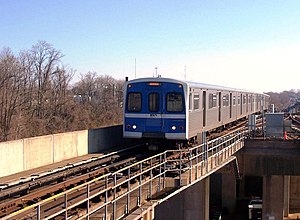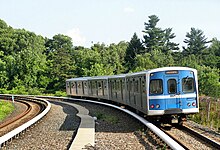

| Metro SubwayLink | |||||||||||||||||||||||||||||||||||||||||||||||||||||||||||||||||||||||||||||||||||||||||||||||||||||||||||||||||||||||||||||||||||||||||||
|---|---|---|---|---|---|---|---|---|---|---|---|---|---|---|---|---|---|---|---|---|---|---|---|---|---|---|---|---|---|---|---|---|---|---|---|---|---|---|---|---|---|---|---|---|---|---|---|---|---|---|---|---|---|---|---|---|---|---|---|---|---|---|---|---|---|---|---|---|---|---|---|---|---|---|---|---|---|---|---|---|---|---|---|---|---|---|---|---|---|---|---|---|---|---|---|---|---|---|---|---|---|---|---|---|---|---|---|---|---|---|---|---|---|---|---|---|---|---|---|---|---|---|---|---|---|---|---|---|---|---|---|---|---|---|---|---|---|---|---|
 | |||||||||||||||||||||||||||||||||||||||||||||||||||||||||||||||||||||||||||||||||||||||||||||||||||||||||||||||||||||||||||||||||||||||||||

Metro SubwayLink train entering Reisterstown Plaza station and bound for Owings Mills station
| |||||||||||||||||||||||||||||||||||||||||||||||||||||||||||||||||||||||||||||||||||||||||||||||||||||||||||||||||||||||||||||||||||||||||||
| Overview | |||||||||||||||||||||||||||||||||||||||||||||||||||||||||||||||||||||||||||||||||||||||||||||||||||||||||||||||||||||||||||||||||||||||||||
| Owner | Maryland Transit Administration | ||||||||||||||||||||||||||||||||||||||||||||||||||||||||||||||||||||||||||||||||||||||||||||||||||||||||||||||||||||||||||||||||||||||||||
| Locale | Baltimore, Maryland, U.S. | ||||||||||||||||||||||||||||||||||||||||||||||||||||||||||||||||||||||||||||||||||||||||||||||||||||||||||||||||||||||||||||||||||||||||||
| Termini |
| ||||||||||||||||||||||||||||||||||||||||||||||||||||||||||||||||||||||||||||||||||||||||||||||||||||||||||||||||||||||||||||||||||||||||||
| Stations | 14 | ||||||||||||||||||||||||||||||||||||||||||||||||||||||||||||||||||||||||||||||||||||||||||||||||||||||||||||||||||||||||||||||||||||||||||
| Website | mta.maryland.gov/metro-subway | ||||||||||||||||||||||||||||||||||||||||||||||||||||||||||||||||||||||||||||||||||||||||||||||||||||||||||||||||||||||||||||||||||||||||||
| Service | |||||||||||||||||||||||||||||||||||||||||||||||||||||||||||||||||||||||||||||||||||||||||||||||||||||||||||||||||||||||||||||||||||||||||||
| Type | Rapid transit | ||||||||||||||||||||||||||||||||||||||||||||||||||||||||||||||||||||||||||||||||||||||||||||||||||||||||||||||||||||||||||||||||||||||||||
| Depot(s) | 5801 Wabash Avenue[1] | ||||||||||||||||||||||||||||||||||||||||||||||||||||||||||||||||||||||||||||||||||||||||||||||||||||||||||||||||||||||||||||||||||||||||||
| Rolling stock | 100 Budd Universal Transit Vehicle cars[2] | ||||||||||||||||||||||||||||||||||||||||||||||||||||||||||||||||||||||||||||||||||||||||||||||||||||||||||||||||||||||||||||||||||||||||||
| Daily ridership | 14,400 (weekdays, Q1 2024)[3] | ||||||||||||||||||||||||||||||||||||||||||||||||||||||||||||||||||||||||||||||||||||||||||||||||||||||||||||||||||||||||||||||||||||||||||
| Ridership | 1,988,300 (2023)[4] | ||||||||||||||||||||||||||||||||||||||||||||||||||||||||||||||||||||||||||||||||||||||||||||||||||||||||||||||||||||||||||||||||||||||||||
| History | |||||||||||||||||||||||||||||||||||||||||||||||||||||||||||||||||||||||||||||||||||||||||||||||||||||||||||||||||||||||||||||||||||||||||||
| Opened | November 21, 1983; 40 years ago (1983-11-21) | ||||||||||||||||||||||||||||||||||||||||||||||||||||||||||||||||||||||||||||||||||||||||||||||||||||||||||||||||||||||||||||||||||||||||||
| Technical | |||||||||||||||||||||||||||||||||||||||||||||||||||||||||||||||||||||||||||||||||||||||||||||||||||||||||||||||||||||||||||||||||||||||||||
| Line length | 15.4 mi (24.8 km)[5] | ||||||||||||||||||||||||||||||||||||||||||||||||||||||||||||||||||||||||||||||||||||||||||||||||||||||||||||||||||||||||||||||||||||||||||
| Track length | 34 mi (55 km)[1] | ||||||||||||||||||||||||||||||||||||||||||||||||||||||||||||||||||||||||||||||||||||||||||||||||||||||||||||||||||||||||||||||||||||||||||
| Number of tracks | 2 | ||||||||||||||||||||||||||||||||||||||||||||||||||||||||||||||||||||||||||||||||||||||||||||||||||||||||||||||||||||||||||||||||||||||||||
| Character | Underground, surface, elevated | ||||||||||||||||||||||||||||||||||||||||||||||||||||||||||||||||||||||||||||||||||||||||||||||||||||||||||||||||||||||||||||||||||||||||||
| Track gauge | 4 ft 8+1⁄2 in (1,435 mm) standard gauge | ||||||||||||||||||||||||||||||||||||||||||||||||||||||||||||||||||||||||||||||||||||||||||||||||||||||||||||||||||||||||||||||||||||||||||
| Electrification | Third rail, 700 V DC[5] | ||||||||||||||||||||||||||||||||||||||||||||||||||||||||||||||||||||||||||||||||||||||||||||||||||||||||||||||||||||||||||||||||||||||||||
| Operating speed | 70 mph (110 km/h)[2] | ||||||||||||||||||||||||||||||||||||||||||||||||||||||||||||||||||||||||||||||||||||||||||||||||||||||||||||||||||||||||||||||||||||||||||
| Highest elevation | 28 ft (8.5 m)[2] | ||||||||||||||||||||||||||||||||||||||||||||||||||||||||||||||||||||||||||||||||||||||||||||||||||||||||||||||||||||||||||||||||||||||||||
| |||||||||||||||||||||||||||||||||||||||||||||||||||||||||||||||||||||||||||||||||||||||||||||||||||||||||||||||||||||||||||||||||||||||||||
The Baltimore Metro SubwayLink is a rapid transit line serving Baltimore, Maryland, and its northwestern suburbs, operated by the Maryland Transit Administration. The segment in Downtown Baltimore is underground, while most of the line outside the central city is elevated or at surface grade.[2] In 2023, the line had a ridership of 1,988,300, or about 14,400 per weekday as of the first quarter of 2024.
The origins of the Metro SubwayLink lie in the Baltimore Area Mass Transportation Plan published in 1965, which envisioned six rapid transit lines radiating out from a central city loop. Planning studies from 1968 proposed a rail transit system 71 mi (114 km) long.[2]
As the vision was translated into reality, the original concept was trimmed to a 28 mi (45 km) system in the Phase 1 plan, published in 1971. This plan involved two of the original six lines: a northwest line from Downtown Baltimore to Owings Mills and a south line to Glen Burnie and the airport. Phase 1 was approved for funding by the Maryland General Assembly in 1972. In response to lobbying by Anne Arundel County residents, the MTA eliminated the south line from Phase 1 plans in 1975; the Baltimore Light RailLink was later built over much of the planned south line corridor.[2]
When the Metro SubwayLink opened on November 21, 1983, only the "Northwest" line of the 1965 plan had come to fruition. This 7.6 mi (12.2 km) segment provided service between Charles Center in Downtown Baltimore and the Reisterstown Plaza shopping center in the northwest of the city. On July 20, 1987, a 6.1 mi (9.8 km) addition extended the line from Reisterstown Plaza to Owings Mills in Baltimore County, with a portion running in the median of Interstate 795. A further extension of 1.6 mi (2.5 km) from Charles Center to Johns Hopkins Hospital opened on May 31, 1995.[1][5] Once the project was completed in 1995, the total cost for the Metro SubwayLink stood at $1.392 billion.[2]
The current system is 15.4 mi (24.8 km) long, consisting of 6.2 mi (10 km) underground, 2.2 mi (3.5 km) elevated, and 7.0 mi (11.3 km) at grade. Eight of its 14 stations are underground, at depths from 52 ft (16 m) to 112 ft (34 m) below street level. Its elevated stations stand from 25 ft (7.6 m) to 28 ft (8.5 m) above ground.[5]
When the system opened, it became the largest single user of Susan B. Anthony dollar coins in the United States.[6]
The installation of underground cellular service in the Metro SubwayLink tunnels began in September 2021 and was originally expected to be completed by June 2022.[7][8] As of January 2024, the work has not been completed.
The Metro SubwayLink has a single line that is shaped like a reverse "J". Trains head south underground from Johns Hopkins Hospital, turn west as they pass under Baltimore's central business district, turn north at Charles Center, and ultimately turn to face northwest at State Center. The route leaves its tunnel northwest of Mondawmin station, entering an elevated structure that parallels Wabash Avenue and the Hanover Subdivision along the former Western Maryland Railway route. The route then enters the median of Interstate 795, which it occupies until it reaches the Owings Mills terminus.
Trains heading towards Johns Hopkins Hospital are referred to as "eastbound", while trains heading towards Owings Mills are "westbound".[9]
A trip from one end of the line to the other takes about half an hour. Headways range from eight minutes during daytime peak to eleven minutes late at night and on weekends. Trains run from 5 a.m. to midnight on weekdays and from 6 a.m. to midnight on weekends.[9]
As of 2024, the fare prices for MTA buses, the Metro SubwayLink, and the Light RailLink travel are as follows:[10]
| Type | Full fare | Senior/Disability | Student | Mobility |
|---|---|---|---|---|
| Single trip | $2.00 | $1.00 | $1.50 | $2.20 |
| Day Pass | $4.60 | $2.30 | – | – |
| Weekly Pass | $22.00 | – | – | – |
| Monthly Pass | $77.00 | $23.00 | – | – |
Farebox recovery in the system is only 28%. This is comparable to other similarly sized systems in the continental United States, but low by international standards.[citation needed]
For fiscal year 2010, the MTA reported 95% on-time performance for the system. It averaged 3.0 passenger trips per revenue mile, with a total of 13.4 million passenger trips for the year. Vehicles operated at an average cost of $11.59 per revenue mile. Local buses, in comparison, performed at a cost of $13.57 per revenue mile.[11]
The Metro SubwayLink has a total of 14 stations.[12]
Most Metro SubwayLink stations are served by a number of MTA bus routes. In 1984, just months after Metro first started operating, many feeder routes were created that were given the designation of a letter (M, P, or R) followed by a number. In 1987, many of these routes were renamed, and only the prefix "M" was used. Over the years, the number of M-lines had shrunk, as many of the routes were consolidated. In 2008, routes designated with the letter "M" were renamed to plain two-digit designations. Finally, on August 30, 2009, the last four were either renumbered or eliminated, with no routing changes made; they continue to act as feeder routes to the Metro SubwayLink.
There is no direct connection from the Metro SubwayLink to the Light RailLinkorMARC commuter rail. However, the Metro SubwayLink's Lexington Market Station is a 200-yard (180 m) walk from the Light RailLink stop of the same name, and the State Center station is about 1.5 blocks away from the Light RailLink's Cultural Center station. Baltimore Penn Station is about a one-half mile walk from State Center, and MARC Camden Station is about five blocks from Lexington Market Metro station.

As of 2024, the line currently uses cars manufactured by the Budd CompanyinNortheast Philadelphia. The first set of additional, new cars are presently manufactured at Hitachi Rail ItalyinFlorida.[11][13][14]
Most of the 100 Budd-built cars were delivered in 1983 with a supplementary set of essentially identical cars being purchased in 1986 for the line expansion. The cars, marketed by Budd as the Universal Transit Vehicle, are identical to those formerly used on the Miami Metrorail; the two agencies built their systems at the same time and saved money by sharing a single order.[2] A number of Budd cars have been retired.[13]
Trains draw power from the electric third rail. The cars are 75 feet (22.86 m) long, 10 feet (3.05 m) wide, and have a top speed of 70 mph (110 km/h). Cars are semi-permanently attached in married pairs and joined up to form 4-car trains, which is the normal train length. 6-car trains are used during peak rush hours. Each car can hold up to 166 passengers (76 seated, 90 standing).[2]
The fleet had a significant overhaul between 2002 and 2005. Seats were reupholstered, and the floors were replaced. External destination rollsigns were replaced with LED displays; internal systems that display train destinations and upcoming stop announcements were also installed.[15]
In July 2017, MTA announced the purchase of 78 new railcars to replace the entire subway fleet. The cars are being built in Florida by Hitachi Rail Italy, and will be similar in appearance to those purchased for the Miami Metrorail.[13][16][17] The Hitachi railcars generate electricity while braking, thus allowing the energy to power certain train systems and enabling the system to become more energy efficient.[13] The first Hitachi cars were delivered in October 2023; the replacement of the rolling stock is set to occur in phases from 2024 to 2026.[13][14]
On February 11, 2018, the MTA announced a month-long closure of the entire system to complete emergency track repairs identified during a safety inspection. An aboveground portion of the system had already been shut down due to emergency inspections and repairs.[18] The system reopened on March 9, 2018.[19]
In the summer of 2023, a fire damaged a portion of the subway system, prompting a brief closure.[20] Regular service resumed a few days later.[20]
|
| |||||
|---|---|---|---|---|---|
| Rapid rail transit |
| ||||
| Passenger rail |
| ||||
| Bus services |
| ||||
| Other topics |
| ||||
Italics denote services currently under construction | |||||
|
Transportation in Metropolitan Baltimore
| |||||
|---|---|---|---|---|---|
| Agencies |
| ||||
| Local Rail |
| ||||
| MARC Train |
| ||||
| Bus |
| ||||
| Other |
| ||||
| Aviation |
| ||||
| Automobile |
| ||||
| Future projects |
| ||||
|
| ||
|---|---|---|
| Topics |
| |
| Attractions |
| |
| Entertainment |
| |
| Education |
| |
| Government |
| |
| History |
| |
| Industry |
| |
| Parks |
| |
| Sports |
| |
| Transportation |
| |
| Misc. |
| |
| ||
|
Currently operating heavy rail rapid transit systems in the United States
| |||||||||||||||||||||||||||||||
|---|---|---|---|---|---|---|---|---|---|---|---|---|---|---|---|---|---|---|---|---|---|---|---|---|---|---|---|---|---|---|---|
| |||||||||||||||||||||||||||||||
Other transit in the United States: | |||||||||||||||||||||||||||||||